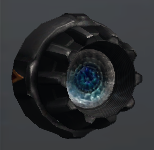Difference between revisions of "Jet engine"
| Line 1: | Line 1: | ||
| − | + | {{stub}} | |
| − | + | [[Image:JetEngine.png|right|thumb|One of the most commonly used Jet engines in KSP. 0.16]] | |
| − | | | ||
| − | | | ||
| − | |||
| − | |||
| − | |||
| − | |||
| − | |||
| − | |||
| − | |||
| − | |||
| − | |||
| − | |||
| − | + | A jet engine is an air-breathing engine which uses onboard fuel and combusts it with the oxygen in the atmosphere, due to its nature its thrust output varies at given altitudes. | |
== Usage == | == Usage == | ||
| − | Unlike rocket engines, a jet draws oxidizer from the atmosphere rather than taking it from an on-board tank. This is represented in-game by a much lower rate of fuel consumption. This engine cannot function effectively at a height of much more than 5km, but it is much more efficient to use jet engines in the lower atmosphere. | + | Unlike rocket engines, a jet draws oxidizer from the atmosphere rather than taking it from an on-board tank. This is represented in-game by a much lower rate of fuel consumption. This engine cannot function effectively at a height of much more than 5km, but it is much more efficient to use jet engines in the lower atmosphere. Jet engines do not perform in the same manner as rocket engines. Since Jet engines rely on a turbine to compress fuel and atmosphere together in order to produce thrust, it takes time to change speed. Also if the throttle is too low the engine will stall. By contrast, rocket engines give instant response to control input. |
| − | + | Currently, jets do not require you to fit air intakes to your spacecraft and function independently of whether you use a fan intake or not. | |
| − | |||
| − | == | + | == Change History == |
| − | + | * 0.15 - First added to the game | |
| − | + | ||
| − | + | ||
| + | == Advantages of Jet Engines == | ||
| + | |||
| + | * Provides excellent fuel efficiency within an atmosphere | ||
| + | * All current jet engines provide thrust vectoring for greater maneuverability | ||
| + | * Uses onboard fuel reserves | ||
| + | * Excellent power to weight ratio | ||
| + | == Disadvantages of Jet Engines == | ||
| − | + | * Cannot be used outside of an atmosphere | |
| + | * Dead weight once no longer useful | ||
| + | * Thrust output changes depending on altitude | ||
| + | * Engine requires time to spool up to maximum thrust potential | ||
| − | + | == Parts == | |
{{Parts}} | {{Parts}} | ||
Revision as of 05:33, 25 August 2012
A jet engine is an air-breathing engine which uses onboard fuel and combusts it with the oxygen in the atmosphere, due to its nature its thrust output varies at given altitudes.
Contents
Usage
Unlike rocket engines, a jet draws oxidizer from the atmosphere rather than taking it from an on-board tank. This is represented in-game by a much lower rate of fuel consumption. This engine cannot function effectively at a height of much more than 5km, but it is much more efficient to use jet engines in the lower atmosphere. Jet engines do not perform in the same manner as rocket engines. Since Jet engines rely on a turbine to compress fuel and atmosphere together in order to produce thrust, it takes time to change speed. Also if the throttle is too low the engine will stall. By contrast, rocket engines give instant response to control input.
Currently, jets do not require you to fit air intakes to your spacecraft and function independently of whether you use a fan intake or not.
Change History
- 0.15 - First added to the game
Advantages of Jet Engines
- Provides excellent fuel efficiency within an atmosphere
- All current jet engines provide thrust vectoring for greater maneuverability
- Uses onboard fuel reserves
- Excellent power to weight ratio
Disadvantages of Jet Engines
- Cannot be used outside of an atmosphere
- Dead weight once no longer useful
- Thrust output changes depending on altitude
- Engine requires time to spool up to maximum thrust potential
